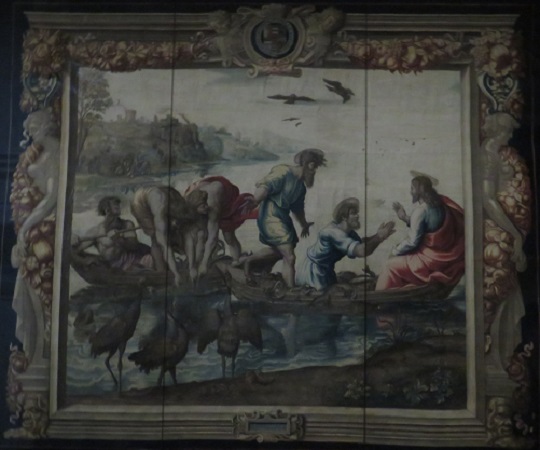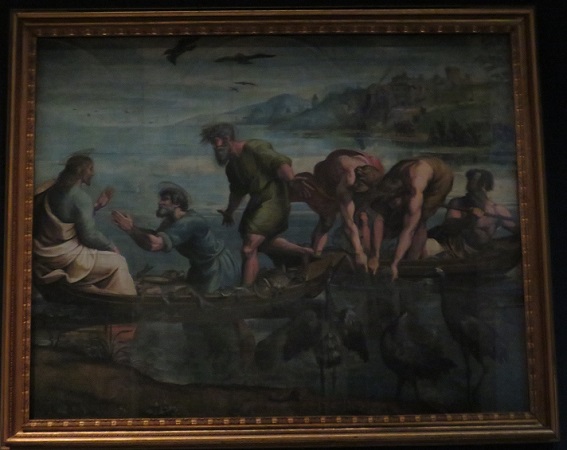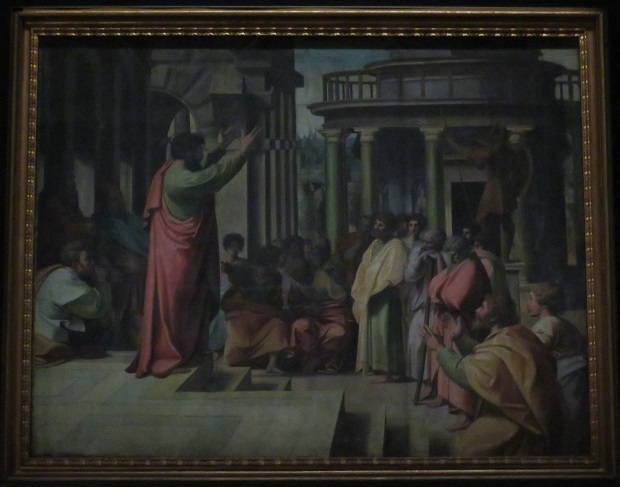
Home
 Raphael Sanzio Scott 87 (1944) The Original Article As Published in Vatican Notes While Raphael was still painting the walls of the Stanze which bear his name in 1513, Pope Leo X requested that he draw cartoons for ten tapestries for the Sistine Chapel. Two of his best pupils, Giovanni Francesco Penni and Giulio Romano, were chosen to continue the paintings, while Raphael worked on the cartoons. They were finished by Christmas, 1516, consisting of ten lightly tinted cartoons of the chief events in the lives of St. Peter and St. Paul. Leo X paid 100 ducats for each of these cartoons which were the exact size and shape which were to be reproduced on the looms. The only place where they could be woven was Flanders. Arras was the former center for tapestries, but since its capture by Louis XI in 1477, it had lost its leadership in this field. Brussels had since become the center of tapestry weaving and thence the cartoons were sent immediately. The work was done with dispatch, since the first design, the Giving of the Keys to Peter, was completed by July, 1517. The tapestries were executed in wool, silk and gold thread under the supervision of Raphael's pupil, Bernhard van Orley. Peter Van Aelst was the supervising weaver and was paid 1500 ducats for each tapestry and awarded the title "Court Purveyor to His Holiness". By July 1519 three of the tapestries had reached Rome and four more came in the fall. They were hung in the Sistine Chapel below the frescoes on St. Stephen's Day. After the death of Leo X they were pawned because of financial distress, then redeemed and restored to the Sistine Chapel. During the Sack of Rome, 1527, mercenary soldiers tried to extract the gold thread by melting it. Pieces of the looted tapestries were purchased back in 1530. Seven tapestries were back by 1544 and two pieces were restored under Julius III which had gone via Venice to Constantinople. All were stolen again during the French Revolution. The tapestries and papal furniture were auctioned and bought by French dealers, then traveled to Genoa and then to the Louvre in Paris. Pius VII secured their return with more of the Napoleonic loot stolen from the papacy. In 1814 they were placed in the Chamber of Pius VI. Gregory XI placed them in the present Gallery of Tapestries. Because of this abuse over the centuries they are not the same beautiful works of art that came from the looms of Brussels, having coarse restorations and patches, and have faded with the years. One has the bottom missing, while others have the wrong borders attached. Seven of the original cartoons were discovered by Rubens in 1630 and belong now to the English Crown, at the South Kensington Museum. All ten cartoons were left in Brussels, after the tapestries had been woven and delivered. Some biographers assume that only the Miraculous Draught of Fishes came entirely from the hands of Raphael; of the seven cartoons in London, some attribute only the heads to Raphael and the rest to his students. Other critics disagree and attribute most of the work to the Master. And so it goes. In the Sistine Chapel the tapestries were hung in a definite order. On the Gospel side were: The Call of Peter under the Destruction of Core; the Healing of the Lame Man under the Giving of the Law at Sinai; the Death of Armenia& under the Passage of the Red Sea; the Stoning of Stephen under the Infancy of Moses; the Miraculous Draught of Fishes under the Circumcision of Moses. On the Epistle side were: The Conversion of Paul under the Baptism of Christ; the Blinding of Elymas under the Purification of the Lepers; the Sacrifice at Lystra under the Calling of the Apostles; the Deliverance of Paul from Prison under the Sermon on the Mount; the Preaching of Paul at Athens under the Giving of the Keys. The tapestries continue the story of the apostles told in the paintings. The only deviation to this order of sequence was that the Miraculous Draught of Fishes was sometimes placed between the Papal throne and the altar wall, so that the wall behind the Papal throne would have behind it subjects illustrative of the papal primacy. The central panels of the tapestries had broad ornamental borders all of which are not preserved. The vertical borders, corresponding to the chapel pillars, had grotesque patterns in color on white or gold. Allegorical figures were grouped between vases and branches. The horizontal borders contain small pictures referring to the life of Paul or Peter. The cartoons preserved in London show in the Miraculous Draught of Fishes the scene referred to in Luke V, with Christ and Peter in one boat and James and John in another, taking in the remainder of the catch. Christ wears a blue mantle over a white garment, with Peter in blue. Peter has just exclaimed "Depart from me, for I am a sinful man," while Christ says: "Fear not. From henceforth you shall catch men." Behind Peter is a figure in green, probably his brother, Andrew. The seven cartoons preserved were: of Peter: The Miraculous Draught of Fishes Call of Peter Healing of Lame Man Death of Annanias of Paul: Blinding of the Sourcerer Elymas Sacrifice of Lystra Preaching at Athens. The cartoons of Raphael are claimed to be the modern counterpart of the classic sculptures of the Parthenon, especially the Miraculous Draught of Fishes and St. Paul at Athens. Their influence is claimed to be greater than the Stanze of Raphael. They are a continuation of the story of salvation, begun in the frescoes on the walls, continued on the ceiling by Michaelangelo and now carried further in the same Sistine Chapel by these tapestries. Reference Pastor. History of the Popes. Vol. VIII, pp 294-317. (From Vatican Notes Volume XII, Number 6, May - June 1964, Page 4) Now For A Bit Of An Update In 2023 I was able to visit the South Kensington Museum, better known as the Victoria And Albert Museum, in London England. High on my priority "must see" list was Raphael's cartoons. I was not disappointed, the designs were truly magnificent! Below are a few pictures from that visit.   The V&A Museum displayed The Miraculous Draught of Fishes tapestry (top) alongside the cartoon (bottom).  This is the cartoon of St. Paul Preaching Wikipedia has a images of all the Raphel Cartoons - Click here All photographs for this article are from the photo collection of Marvin Lanahan, used with permission. |